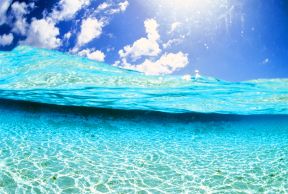 Claims in the media about a great garbage patch in the Pacific Ocean being “twice the size of Texas” exaggerated the actual size by two hundred thousand percent, according to an analysis by an Oregon State University scientist. If you look at the actual area of the plastic itself, the amount is actually less than 1 percent of the size of Texas.
Claims in the media about a great garbage patch in the Pacific Ocean being “twice the size of Texas” exaggerated the actual size by two hundred thousand percent, according to an analysis by an Oregon State University scientist. If you look at the actual area of the plastic itself, the amount is actually less than 1 percent of the size of Texas.
Further claims that the oceans are filled with more plastic than plankton, and that the patch has been growing tenfold each decade since the 1950s are equally misleading, pointed out Angelicque “Angel” White, an assistant professor of oceanography at Oregon State.
“There is no doubt that the amount of plastic in the world’s oceans is troubling, but this kind of exaggeration undermines the credibility of scientists,” White said. “It is simply inaccurate to state that plastic outweighs plankton, or that we have observed an exponential increase in plastic.”
White has pored over published literature and participated in one of the few expeditions solely aimed at understanding the abundance of plastic debris and the associated impact of plastic on microbial communities.
She says, while it isn’t trivial, the total amount of plastic is a small fraction of what was reported and it certainly isn’t growing. She described the study’s conclusion as “unexpected”.
Another way to look at it, White said, is to compare the amount of plastic found to the amount of water in which it was found. If the surface area of the ocean were equivalent to a football field, the amount of plastic recovered would not even extend to the 1-inch line.
The hyperbole about plastic patches saturating the media rankles White, who says such exaggeration can drive a wedge between the public and the scientific community. One recent claim that the garbage patch is as deep as the Golden Gate Bridge is tall is completely unfounded, she said.
White says there is growing interest in removing plastic from the ocean, but such efforts will be costly, inefficient, and may have unforeseen consequences. It would be difficult, for example, to “corral” and remove plastic particles from ocean waters without inadvertently removing phytoplankton, zooplankton, and small surface-dwelling aquatic creatures, which are the heartbeat of the ocean.
The relationship between microbes and plastic is what drew White and her C-MORE colleagues to their analysis in the first place. During a recent expedition, they discovered that photosynthetic microbes were thriving on many plastic particles, in essence confirming that plastic is prime real estate for certain microbes.
White also noted that while plastic may be beneficial to some organisms, it can also be toxic when containing PCB.
“On one hand, these plastics may help remove toxins from the water,” she said. “On the other hand, these same toxin-laden particles may be ingested by fish and seabirds. Plastic clearly does not belong in the ocean.”
Among other findings, which White believes should be part of the public dialogue on ocean trash:
* Calculations show that the amount of energy it would take to remove plastics from the ocean is roughly 250 times the mass of the plastic itself;
* There are areas of the ocean largely unpolluted by plastic. A recent trawl White conducted in a remote section of water between Easter Island and Chile pulled in no plastic at all.
“If there is a takeaway message, it’s that we should consider it good news that the ‘garbage patch’ doesn’t seem to be as bad as advertised,” White said, “but since it would be prohibitively costly to remove the plastic, we need to focus our efforts on preventing more trash from fouling our oceans in the first place.”
The expedition was part of research funded by the National Science Foundation through C-MORE, the Center for Microbial Oceanography: Research and Education.




















This is very interesting people should help clean the ocean a lot more often. I will try my very best to keep the ocean clean. 🙂
Not surprised. I think in some respects the powers that be want us to think the environment is too far gone to save. (Exaggerated CO2 levels, glacier melt, and now the oceans’ garbage)
Maybe but we do need to stop buying water in plastic bottles. Ironically the bottles of ‘pure water’ we buy are one of the biggest contributors to this plastic problem. Drink filtered tap water!